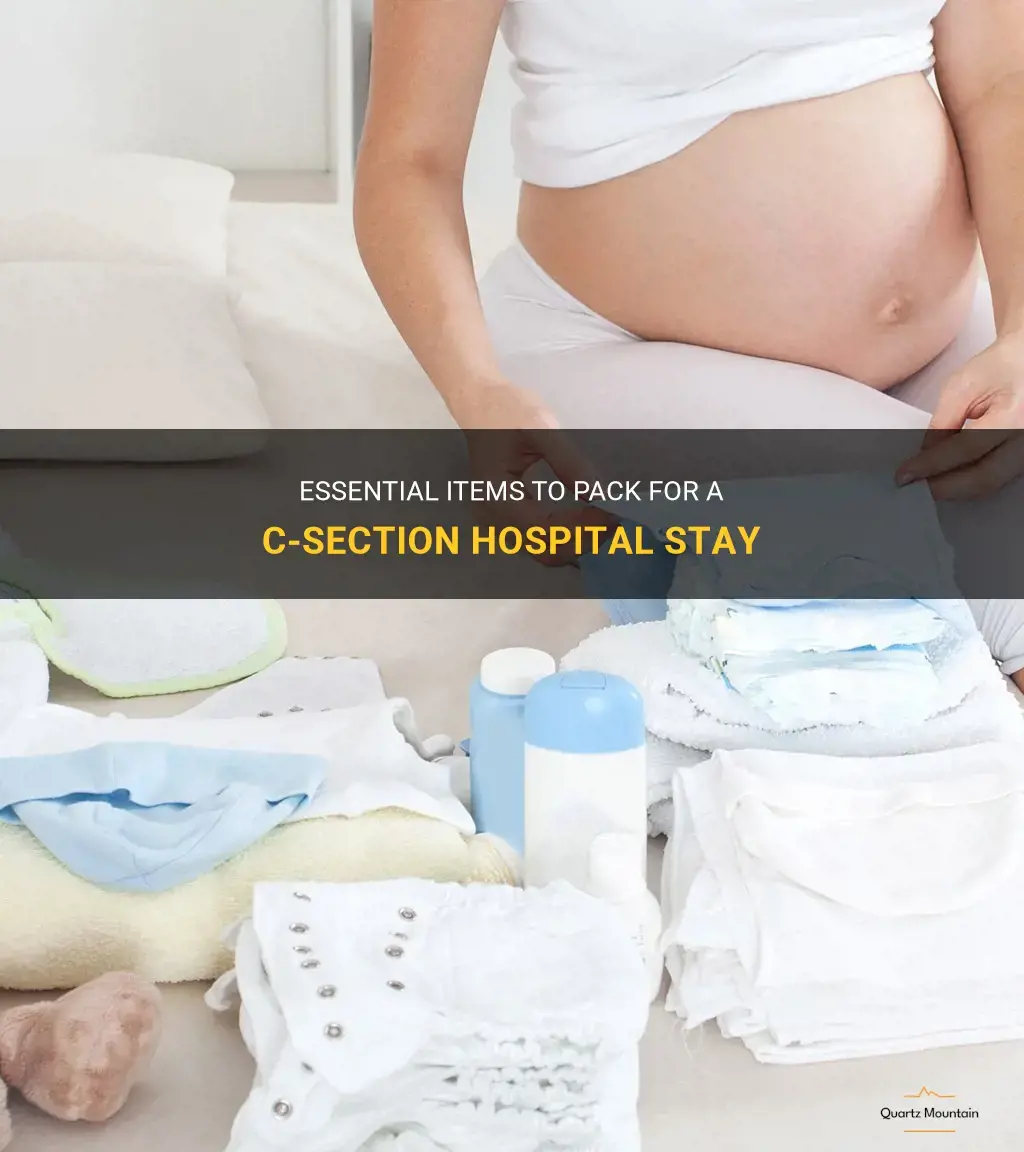
Planning ahead and packing all of the essential items for your upcoming C-section hospital stay is crucial to ensuring a smooth and comfortable recovery. From comfortable clothing to baby essentials, there are a variety of items you'll want to have on hand. In this article, we'll explore some must-have items for your C-section hospital stay, helping to ease any stress or uncertainty you may have as you prepare for this exciting new chapter in your life.
| Characteristics | Values |
|---|---|
| Comfortable Clothing | Loose-fitting clothing |
| Toiletries | Toothbrush, toothpaste, soap, etc |
| Maternity Pads | Absorbent and comfortable |
| Nursing Bra | Supportive and easy to open |
| Breastfeeding Supplies | Breast pump, milk storage bags |
| Extra Underwear | Disposable or comfortable |
| Slippers or Non-slip Socks | Easy to wear and cozy |
| Phone Charger | Stay connected with loved ones |
| Baby Clothes and Blankets | Swaddles, onesies, cozy blankets |
| Snacks | Healthy and convenient |
| Entertainment | Books, magazines, or tablet |
What You'll Learn
- What essential items should I pack in my hospital bag for a C-section delivery?
- Are there any specific clothing items or maternity wear that is recommended for a C-section?
- Should I pack any personal hygiene products or toiletries for a C-section hospital stay?
- Are there any specific items I should bring to make myself more comfortable during recovery after a C-section?
- Is there anything else I should consider packing for a C-section delivery that may not be obvious?

What essential items should I pack in my hospital bag for a C-section delivery?
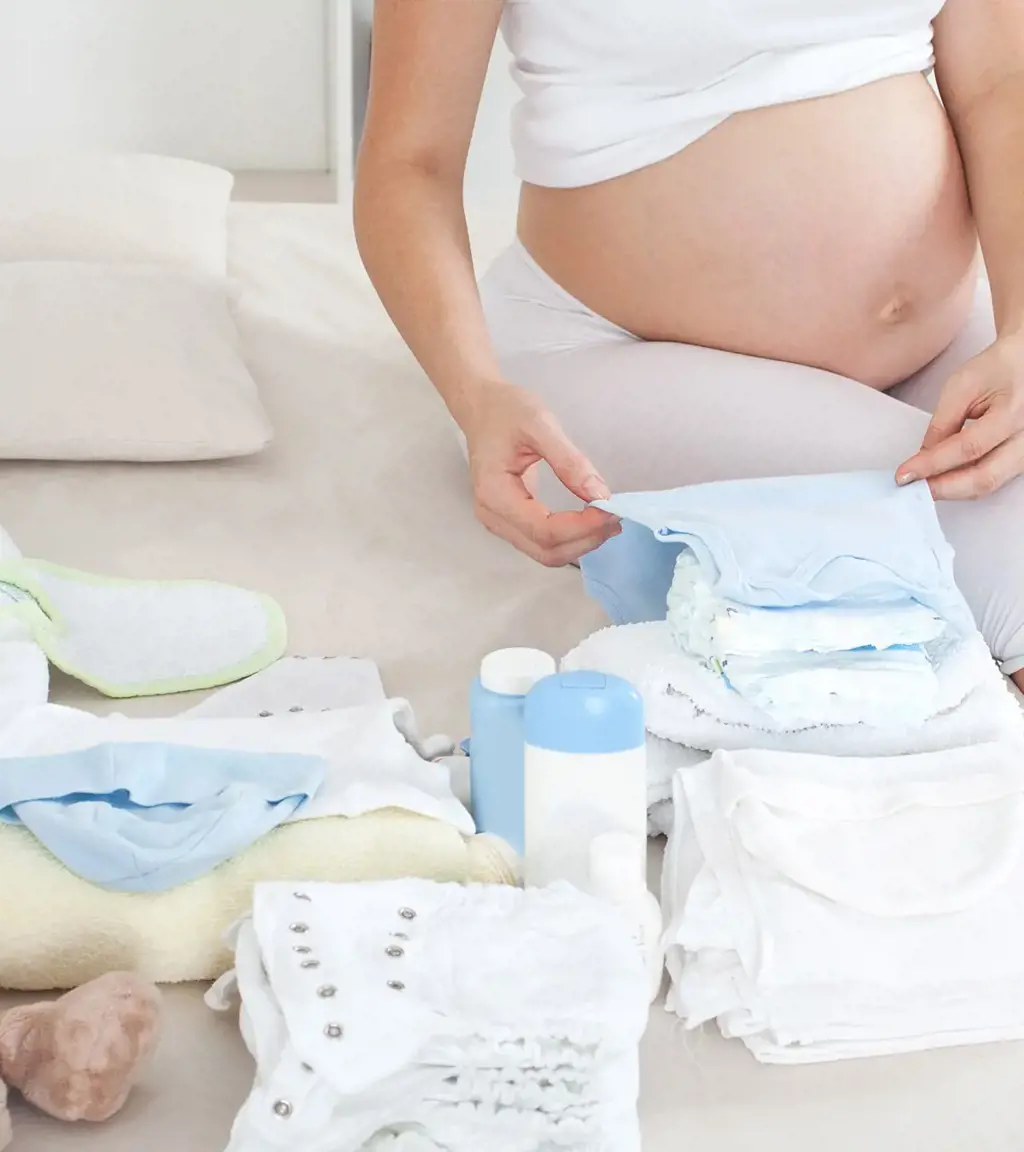
Packing your hospital bag is an important task to prepare for the arrival of your baby, especially if you're having a C-section delivery. While the hospital will provide many of the essentials, there are a few items you should pack to make your stay more comfortable. Here are some essential items to include in your hospital bag for a C-section delivery:
- Comfortable Clothing: Pack loose, comfortable clothes that are easy to put on and take off. You'll want to avoid tight clothing that puts pressure on your incision site. Consider bringing a robe, nightgowns, pajamas, or loose-fitting pants and tops.
- Slip-on Shoes: After your C-section, it may be difficult to bend over and tie your shoes. Pack a pair of slip-on shoes or slippers to make it easier to get around the hospital.
- Maternity Bras and Nursing Pads: If you plan to breastfeed, pack a few nursing bras that provide support and easy access for nursing. Nursing pads are also essential to prevent leaks and keep your clothes dry.
- Toiletries: Bring your own toiletries such as toothbrush, toothpaste, shampoo, conditioner, soap, and lotion. Hospital toiletries might not be of your preference, so having your own can make you feel more comfortable.
- Entertainment: During your stay, you'll have some downtime. Bring a book, magazine, or your favorite electronic device such as a tablet or laptop to keep yourself entertained.
- Snacks: Pack some nutritious snacks to keep your energy up during your hospital stay. Granola bars, nuts, dried fruits, and crackers are good options to have on hand.
- Extra Pillow and Blanket: Hospital pillows and blankets may not be as comfortable as your own. Bringing an extra pillow and blanket can help you get more comfortable and facilitate better rest.
- Phone and Charger: Don't forget to pack your phone and charger to stay connected with your loved ones and capture precious moments with your new baby.
- Baby Essentials: While the hospital will provide basic items for your baby, it's still a good idea to pack a few essentials. Bring a going-home outfit, receiving blankets, diapers, wipes, and a baby hat.
- Important Documents: Pack important documents such as your driver's license, insurance card, and birth plan. It's also a good idea to have a list of important phone numbers, including your doctor and emergency contacts.
Remember to pack these items well in advance of your due date, as you may go into labor earlier than expected. Having these essential items in your hospital bag will ensure a more comfortable and prepared experience for your C-section delivery.
Mistakes to Avoid When Packing a POD
You may want to see also

Are there any specific clothing items or maternity wear that is recommended for a C-section?

Women who have undergone a C-section surgery often have specific concerns about what clothing items or maternity wear would be most comfortable and practical during their recovery period. It is important to choose clothes that are gentle on the incision site and provide support to the abdominal area. In this article, we will discuss some recommendations for clothing items and maternity wear for C-section recovery.
- Loose, Soft Fabrics: It is important to choose clothes made of loose and soft fabrics to avoid irritation and discomfort on the surgical incision. Cotton is a popular choice as it is breathable and gentle on the skin. Avoid clothes with rough seams or materials that can rub against the incision site.
- High-Waisted Bottoms: Opt for high-waisted bottoms, such as leggings or skirts with elastic waistbands, that sit comfortably above the incision site. These will provide support to the abdominal area and avoid putting pressure on the healing wound. Additionally, high-waisted bottoms help to camouflage any post-surgery bloating or swelling.
- Seamless Underwear: Choose seamless underwear that does not have any irritating seams or tags. Look for low-rise or full-coverage options to ensure comfort and support. Some companies even offer specialized postpartum underwear that provides gentle compression and control for the abdominal area.
- Abdominal Support Bands: Abdominal support bands or belts can be beneficial for C-section recovery. These bands provide gentle compression and support to the abdominal muscles, which can help with pain relief and promote healing. It is important to consult with your healthcare provider before using any support bands to ensure they are suitable for your specific situation.
- Nursing Bras for Comfort: If you plan on breastfeeding, consider investing in nursing bras that are comfortable and supportive. Look for bras with wide shoulder straps and soft fabrics to minimize any discomfort around the incision site. Some nursing bras also have adjustable bands that can accommodate changes in breast size due to milk production.
- Maternity Dresses with Button-Fronts: Maternity dresses with button-fronts can be a convenient option for easy access during the recovery period. These dresses can be easily undone for breastfeeding or to access the incision site for dressing changes. Opt for dresses made of breathable fabrics that allow for easy movement and comfort.
Remember, everyone's recovery from a C-section is different, so it is important to listen to your body and choose clothing that feels comfortable for you. It may be beneficial to try on different options before your surgery to see what works best for you. Additionally, keep in mind that it may take several weeks or even months for your body to fully recover, so be patient with yourself during this time.
Essential Items to Pack for a Relaxing Spa Day
You may want to see also

Should I pack any personal hygiene products or toiletries for a C-section hospital stay?
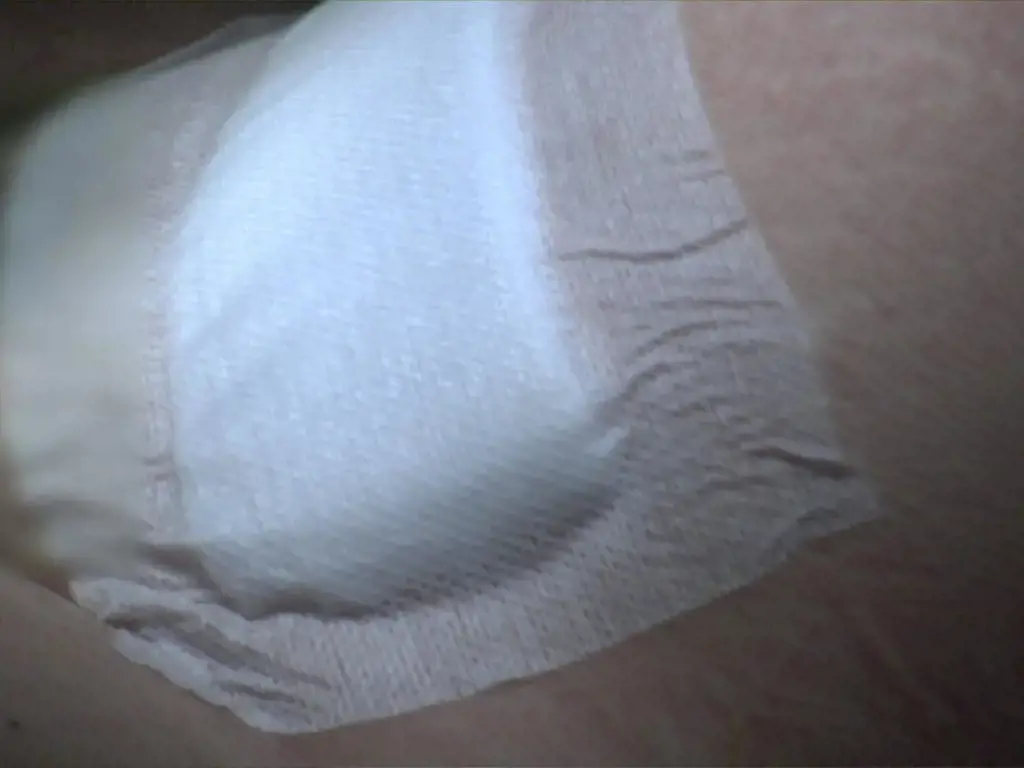
Going in for a C-section can be a nerve-wracking experience, and it's natural to want to be as prepared as possible. One question that often comes up is whether or not you should pack any personal hygiene products or toiletries for your hospital stay. The answer to this question can vary depending on the hospital's policies and your personal preferences, but there are a few things to consider when making this decision.
First and foremost, it's important to check with your hospital to see what they provide for you during your stay. Many hospitals will supply basic toiletries such as soap, shampoo, and toothpaste, as well as essential items like sanitary pads and underwear. They may also provide any necessary medications or medical supplies. However, these provisions can vary from hospital to hospital, so it's crucial to find out exactly what will be available to you.
Once you have a clear understanding of what the hospital will provide, you can decide whether or not you want to pack any additional personal hygiene products. Some women prefer to bring their own toiletries to make their hospital stay more comfortable and familiar. This can include items such as your favorite shampoo and conditioner, face cleanser, moisturizer, and perfume. Having these items can help you feel refreshed and more like yourself during your recovery.
Additionally, packing your own toiletries can be beneficial if you have specific sensitivities or preferences. For example, if you have sensitive skin and need to use a certain brand of soap or lotion, it may be a good idea to bring it from home. Similarly, if you prefer natural or organic products, you may want to pack those as well. By having your own toiletries, you can ensure that you're using products that are safe and suitable for your needs.
While bringing your own toiletries can be helpful for personal comfort, it's important to pack judiciously. Remember that you may have limited space in your hospital room, so it's best to bring only the essentials. Stick to travel-sized containers to save space, and consider packing a small toiletry bag or organizer to keep everything neat and easily accessible.
In addition to personal hygiene products, it's also a good idea to pack other essential items for your C-section hospital stay. This can include comfortable clothing, such as loose-fitting pajamas or maternity underwear, as well as any necessary medications, nursing bras, and breast pads. You may also want to bring items to keep you entertained during your stay, such as books, magazines, or a tablet.
In conclusion, whether or not you should pack personal hygiene products or toiletries for your C-section hospital stay depends on your personal preferences and the provisions of the hospital. It's important to check with the hospital to see what they provide and then assess whether you want to bring your own items for added comfort and familiarity. Just remember to pack judiciously and prioritize essential items to ensure a comfortable and smooth recovery.
Essential Items to Pack for a Relaxing Day at the Lake
You may want to see also

Are there any specific items I should bring to make myself more comfortable during recovery after a C-section?
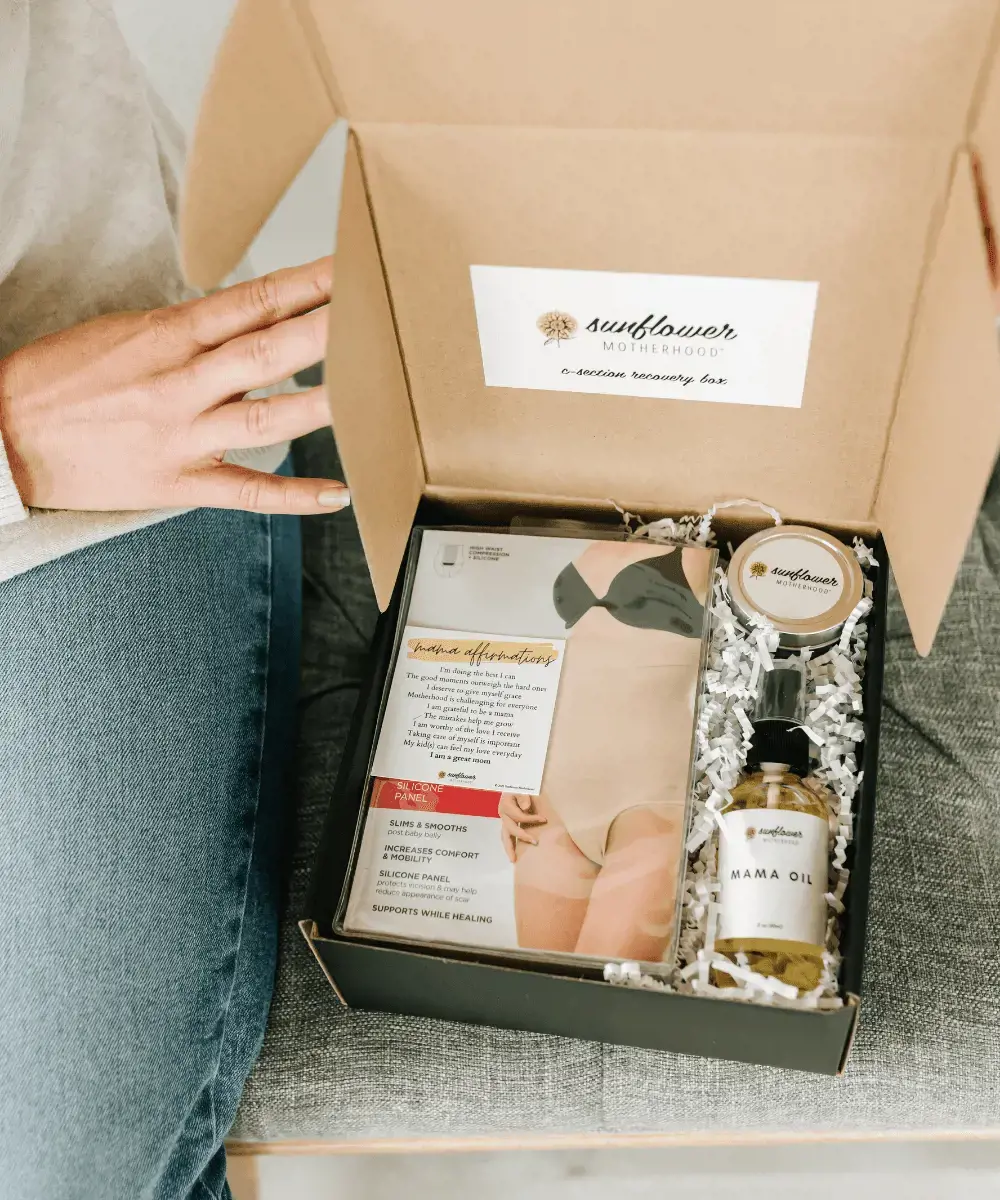
Recovering from a C-section can be a challenging and uncomfortable process. It's important to be prepared and have the necessary items on hand to make yourself as comfortable as possible during this time. Here are some specific items that can help with your recovery:
- Compression underwear: After a C-section, you may experience swelling and discomfort in the abdominal area. Compression underwear can help to minimize swelling and provide support to the incision site. Look for underwear specifically designed for postpartum recovery, as they are usually made of soft, breathable fabric and have a high waistband for added support.
- Loose-fitting clothing: During the first few weeks of recovery, you'll want to avoid wearing tight-fitting clothing that puts pressure on your incision site. Opt for loose-fitting tops and bottoms that are comfortable and easy to put on and take off. Avoid anything with a waistband that sits directly on your incision site, as this can cause irritation and slow down the healing process.
- Nursing bras: If you plan on breastfeeding, it's essential to have a few comfortable nursing bras on hand. Look for bras that have easy-to-open cups for convenient nursing access. It's important to choose bras made from soft, breathable fabric that provides adequate support without causing any discomfort or pressure on the incision site.
- Nursing pillows: Nursing pillows can be a lifesaver during the early days of breastfeeding. They provide support for your baby, allowing you to maintain a comfortable nursing position without straining your back or incision site. Look for pillows that are adjustable and have a firm yet soft filling.
- Pain medication: Your doctor will likely prescribe pain medication to help manage any discomfort or pain you may experience after a C-section. Make sure to have a supply of pain medication on hand so you can take it as needed. Follow your doctor's instructions regarding dosage and frequency, and don't hesitate to reach out to them if you have any concerns or questions.
- Stool softeners: After a C-section, you may experience constipation due to the anesthesia and pain medication. Taking stool softeners can help prevent constipation and make bowel movements more comfortable. Talk to your doctor about which stool softener is safe to take and the recommended dosages.
- Pads and disposable underwear: You can expect to have vaginal bleeding or discharge, known as lochia, for several weeks after a C-section. Stock up on large pads or maternity pads to absorb the bleeding and prevent leaks. It may also be helpful to have some disposable underwear on hand, as they can be more comfortable and convenient during this time.
- Ice packs and heating pads: Ice packs can help reduce swelling and relieve pain around the incision site. Wrap the ice pack in a cloth and apply it to the affected area for 10 to 15 minutes at a time, several times a day. Heating pads, on the other hand, can help soothe sore muscles and provide comfort. Make sure to use a low or medium setting and avoid placing the heating pad directly on your incision site.
In addition to the items mentioned above, it's important to have a support system in place. Don't be afraid to ask for help from family and friends during your recovery period. They can assist with household chores, cooking, and taking care of your other children, if applicable.
Remember, every woman's recovery experience is unique, so it's important to listen to your body and go at your own pace. If you have any concerns or questions, don't hesitate to reach out to your healthcare provider for guidance and support.
Essential Tips for Packing for RAGBRAI: What Every Cyclist Needs
You may want to see also

Is there anything else I should consider packing for a C-section delivery that may not be obvious?
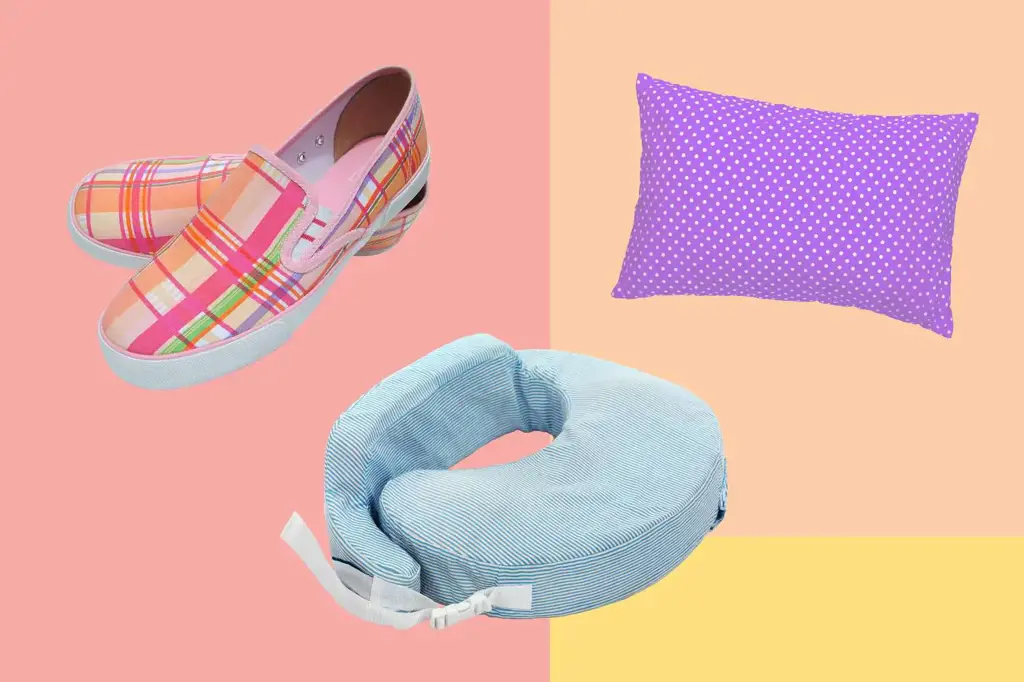
When it comes to preparing for a C-section delivery, there are a few things that you may not have considered packing. While the essentials such as clothes for both mom and baby, toiletries, and important documents like insurance cards and birth plans are obvious, there are a few extra items that can make a C-section delivery more comfortable.
- Compression garments: After a C-section, it is common for women to experience swelling and discomfort in the abdominal area. Compression garments, such as postpartum belly wraps or support panties, can help reduce swelling, support the incision site, and provide added comfort during the recovery process.
- Extra pillows: Having extra pillows on hand can make a world of difference in terms of comfort during recovery. Use one to support your incision site while lying down, and another to prop yourself up while feeding the baby or resting in a seated position.
- Loose-fitting, high-waisted underwear: Regular underwear can be uncomfortable and irritating to the incision area. Look for high-waisted underwear that is made of a soft and breathable fabric to provide gentle support without putting pressure on the incision.
- A comfortable nursing bra: If you plan to breastfeed, having a comfortable nursing bra is essential. Look for one that provides good support but is not too tight. Avoid underwire bras as they can put pressure on the incision and cause discomfort.
- Nipple cream: Breastfeeding can be tough on the nipples, especially in the early days. Packing a lanolin-based nipple cream can help soothe and protect your nipples from any potential soreness or cracking.
- Stool softeners: After surgery, it is common for women to experience constipation due to the effects of anesthesia and pain medications. Taking stool softeners can help prevent this issue and make bowel movements more comfortable.
- Entertainment: While recovering from a C-section, you may find yourself spending a significant amount of time resting in bed. Packing some form of entertainment, such as books, magazines, or a tablet with movies or TV shows, can help pass the time and keep your mind occupied.
- Snacks: Hospital food may not always be to your liking, and hunger can strike at any time. Packing some healthy and non-perishable snacks, such as granola bars, dried fruit, or nuts, can help keep you fueled and satisfied during your hospital stay.
It's important to note that every woman's experience with a C-section delivery is different, and what works for one person may not work for another. Prioritize your comfort and personal needs, and don't be afraid to consult with your healthcare provider for specific recommendations based on your individual circumstances.
Essential Items to Pack for a 5 Day Trip: Your Ultimate Checklist
You may want to see also
Frequently asked questions
When packing for a hospital c-section, it's important to include essential items such as comfortable clothing for you, a robe or sweater for layering, slip-on shoes or slippers, toiletries, breastfeeding essentials if you plan to breastfeed, phone charger, and personal items like your own pillow or blanket for added comfort.
Yes, it's recommended to pack loose-fitting, comfortable clothing that won't put pressure on your incision. Look for pants or skirts with an elastic waistband, loose tops that button or zip in the front for easy breastfeeding access, and underwear that is comfortable and won't irritate your incision site.
Along with the usual newborn essentials like clothing, diapers, wipes, and swaddling blankets, you may also want to pack a car seat for your baby's trip home. It's also a good idea to have a going-home outfit for your baby to wear when leaving the hospital.
While hospitals typically provide basic toiletries like soap, shampoo, and lotion, you may prefer to bring your own for added comfort. Pack your preferred toothbrush, toothpaste, shampoo and conditioner, body wash or soap, moisturizer, and any other personal care items you typically use.
Consider bringing some entertainment options like books, magazines, or a portable device with downloaded movies or shows to keep yourself occupied during your hospital stay. It's also a good idea to have a list of important phone numbers and your hospital paperwork ready to go. Additionally, packing snacks and drinks can be helpful in case you get hungry or thirsty during your stay.







